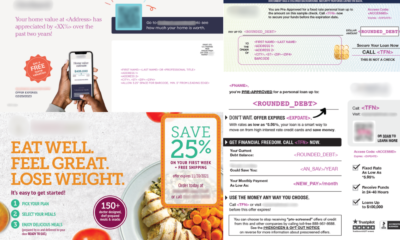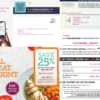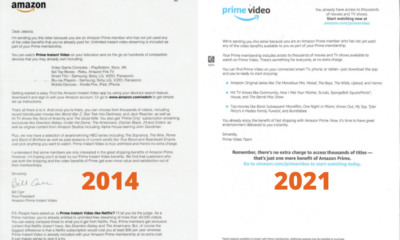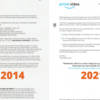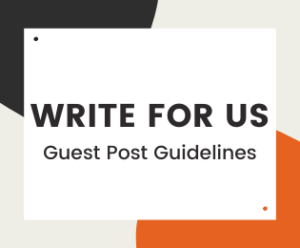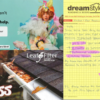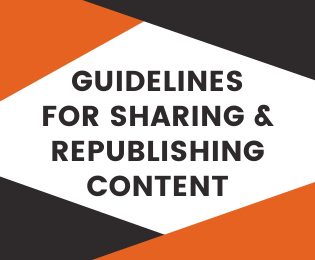RESEARCH & REPORTS
How COVID-19 Affected Direct Mail Marketing — Part 1
As COVID-19 has raged across America and the world, it’s had a measurable effect on the amount of mail sent by marketers.
As COVID-19 has raged across America and the world, it’s had a measurable effect on the amount of mail sent by marketers and received by our nationwide Who’s Mailing What! panelists. We’ve looked at the overall volume tracked in February through April 2020, and while there has been a decrease, some individual industry subcategories show impressive month-over-month increases from which we can draw some interesting conclusions.
UPDATE: Statistics for May Mail We Collected
From April to May, the mail collected by Who’s Mailing What! was mostly either flat or saw slight declines in most categories.
Business Services mail, though, dropped by 36%. Recreation & Travel? Down by a whopping 55%. Neither of those are much of a surprise, given the massive slowdown of most business operations and travel across the country.
The one exception? Retail. This sector jumped from 24.8% of our mail in April to 33.1% in May.
Marketers have had some time to process the shocks caused by the health crisis, and adapt their mail.
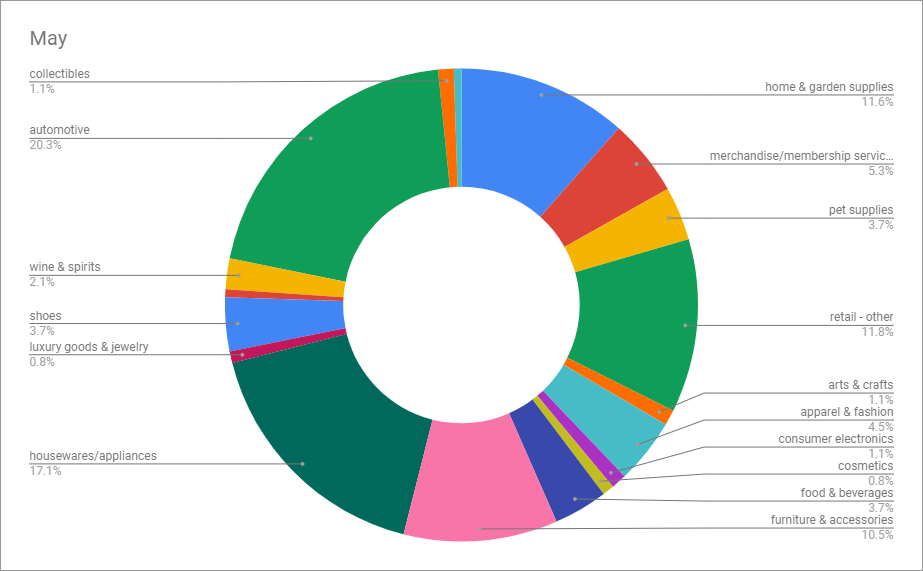
The May leaders:
Automotive went from 17.6% to 20.3% of total volume. Many vehicle showrooms were closed across the nation. But much of the mail was for car maintenance, as those services were usually considered “essential”.
For example, a local Hyundai dealership mailed a postcard proclaiming “We’re open and here to help” on the address side (see below). On the reverse side, it notes that “our team is here for you and the community as we all deal with COVID-19.”

Housewares/Appliances increased from 11% of our total in April to 17.1%. With millions of Americans at home for longer due to stay-at-home orders and business closings, marketers clearly saw an opportunity here.
Retail – Other includes broad interest retailers like Target, Lowe’s, Walmart … all of which have stayed opening during the pandemic. Their share moved from 11% to 11.8%, not a surprise.
Pet Supplies, though, jumped from 1.8% in April mail to 3.7% in May. Maybe this reflects what other indicators do: the greater amount of time people spent at home. Also, according to news stories, pet adoptions have seen large increases during this initial outbreak/shutdown phase.
UPDATE: What Happened in May Mail’s Creative
In March and April, there was fear and enormous uncertainty that most brands simply didn’t know how to address with their mail. So they cut back or stopped their campaigns and waited.
The direct mail from May that we collected shows that marketers are starting to adapt to the new normal – a mix of evolving guidelines, shut down orders, and reopening of state and local economies.
With the pandemic breaking out during an election year across America, political campaigns took note of the changes it forced. In many cases, mail pieces informed voters of new voting dates as well as vote-by-mail options. For example, one local party mailer informed voters that they didn’t need an excuse for this alternative. “Be Safe! Vote at Home! Vote by Mail!” it said.
While many national retail chains were shuttered or curtailed by the COVID-19, some exceptions stood out for how they aimed to reassure the public that they were working to keep customers safe in this new environment. One example was shown above from a Hyundai dealer.
In another example, Total Wine & More listed how it had made operational changes in its stores: “Shop Safely. Measures we’ve taken to keep you, our community and employees safe.” (see below)

In addition, local and national companies alike modified their usual ads in co-operative or shared mailers to inform consumers both that they are still open, had instituted new protection and customer contact measures.
Some examples:
- “We are here for you … Visit samsclub.com or scan the QR code to learn more about the steps we are taking in response to COVID-19.” (Sam’s Club)
- “Now offering virtual appointments too!” (Renewal by Andersen)
- “COVID-19 SAFETY is our TOP PRIORITY” (local landscaper)
- “WE’RE OPEN And AN ESSENTIAL BUSINESS. We Are Following All CDC Guidelines.” (local Ford service center)
- “No-contact home repairs & replacements.” (regional home repair contractor)
- “10% OFF Curbside Pickup” (local cafe & BYOB)
Even as more businesses and retail stores reopen across the country, the social distancing, mask-wearing, and other health and safety requirements and suggestions are here to stay for now. Marketers will become more comfortable expressing empathy, and sharing with their customers what they’re doing to create a safe buying experience in a difficult health and financial environment.
What Our Statistics Show
Before considering individual subcategories, please be aware that mail volume traditionally rises in the United States in Spring months. That didn’t happen in 2020.

A sample of overall volume of our panelists revealed that the number of pieces they received from February compared to April dropped dramatically, up to 84% in one case, 80% in another. Other panelists recorded decreases measured from 67% to 78%. In every one, the biggest drops occurred in April.
Two categories that showed big drops included travel and real estate. From February to April, the number of travel pieces received went down by 37.5%. This is normally a time that sees increases to promote the late Summer and Fall hotel, trip, and cruise offerings
.
And Real Estate mailings also decreased by 37.5%. Warmer weather means a better time to sell a home – under normal circumstances. Big volume increases were seen in several categories. For example, mail campaigns from nonprofits increased by 38.7% over the February (6.8% of mail) to April range (11.1% of mail). This makes perfect sense, as some carried out their usual Spring appeals, and may also have added efforts for coronavirus-related fundraising. Internet and Telecom mailings saw an increase from February through April of 11.6%. While it may not be directly-related to the pandemic, telecom companies have increased capacities to deal with record numbers of people working from home.

For all of the subcategories we track under “Retail” at Who’s Mailing What!, the largest jump was 317% for the home and garden category from February (3% of all mail) to April (12.5% of mail). Some of this could be explained by the simple change of seasons, but again, anecdotal evidence and news coverage strongly suggests that Americans took a higher than normal interest in these activities thanks to stay-at-home orders.
Why Some Direct Mail Volume Declined
The onset of the pandemic came suddenly in most of the United States. Undoubtedly, some mail campaigns were already well underway – at the printer, a USPS Network Distribution Center, or a mailbox – when many states began to shut down under their governors’ orders in March.
Some mail continued onward to customers. But not as much as typically shows up at the beginning of Spring in the United States. Why? It’s very likely that a combination of factors cut the volume of the mail as coronavirus hit the country. First, the large-scale closure of stores. Not just the big retail chains, but smaller chains and small businesses of all kinds. If it’s not classified as an “essential” business, it had to close. Admittedly, some shortly later reopened following an appeal or re-assessment. Others have reopened in some places following a relaxation of mandates.
Second, it’s also worth pointing out that some printers were shut down briefly in the initial flurry of closings, but were successful in lobbying for an exemption. So marketers pulled back.
Also, who wants to mail when so much becomes unknown, even chaotic, overnight? The marketing environment – except for essential items like groceries, medicine, and gasoline – is very questionable. With a simultaneous and ongoing health and economic emergency, some mailers made alterations or additions to their campaigns. Others began to send out mailers to offer help specifically for people worried about coronavirus.
The American Lung Association, for example, included a special buck slip in its annual fund effort. It listed tips on “staying healthy during an outbreak,” as well as assured the donor that “we are taking action” against the coronavirus, such as research.

Rosemont College went further, pivoting to recast its Experience Fund appeal. “These are extraordinary times,” its headline read, alongside a photo of an empty Spring scene on campus. Because school activities moved online, it explains, all gifts will go to help students and staff learn and work remotely.
“I’m here to help you and your family during this health crisis” says Indiana State Representative in a headline on a postcard mailed to constituents. Besides answering FAQs, the mailer also includes key contact websites for local resources as well as the Centers for Disease Control and Prevention (CDC).
Another postcard, from Tampa General Hospital, asks “EXPERIENCING ANY OF THESE SYMPTOMS?” Recipients who answer yes are directed to use the hospital’s app for a virtual visit with a board-certified doctor for further evaluation.

What To Do Next With Your Direct Mail
So what should marketers do now to move forward? Remember, there are health and economic uncertainties that have never been encountered on this scale before. At the same time, record numbers of people are at home, with time to spend looking at the mail you send to them. By being creative, and staying nimble and flexible, you can take advantage of opportunities others don’t see or may not have resources ready to go.
- Nonprofit fundraisers, as I noted in the previous section, have already begun to adapt to the new normal. Many of them have experience doing so, following challenges like 9/11, numerous hurricanes and other natural disasters, as well as painful economic recessions. They’re better at expressing empathy as well as recasting how their missions can continue in light of a new crisis.
- With near record unemployment and business losses, many Americans will have less money to spend on luxury goods, jewelry, higher-end vehicles. Expect more experts marketing financial services to focus more than ever on money-saving offers.
- Images – for now – will probably shift to reflect the new reality of social distancing, better hygiene, and other measures. So think less crowdshots and handshakes, more careful spacing and facemasks.
- But a big change, as I noted above, is to look for ways to continue marketing, assuming that your company is open and operating at some level, or soon will be. Provide information and content that makes it easier for your customers to do business with you, even if it is at more of a physical distance. Local businesses as well as larger brands that never put much thought into e-commerce may need more than ever before as a lifeline both now and through any future reopening and shutdown cycles.
But unless you use mail, your prospects may not know what you can do now. For example, many restaurants have remained open by shifting to delivery, takeout/curbside pickup, and DIY options. And many car dealers and maintenance shops now have contactless pickup and dropoff service.
Above all – be positive. Customers want to feel that they are in control. At the same time, they want to know that you care about their concerns, such as financial and health security. They need reassurance that you are taking measures to keep them and the larger community safe during these difficult times.
Final Thoughts
There is so much we can only guess at now. The world will never be as it was. But there is one certainty – people still have needs and wants. Marketers and nonprofits will still make an offer to help with goods and services, as they’ve always done. As long as the coronavirus disrupts American life, we at Who’s Mailing What! will continue to track how it changes industry categories and subcategories, and report on this blog what they mean for you.














